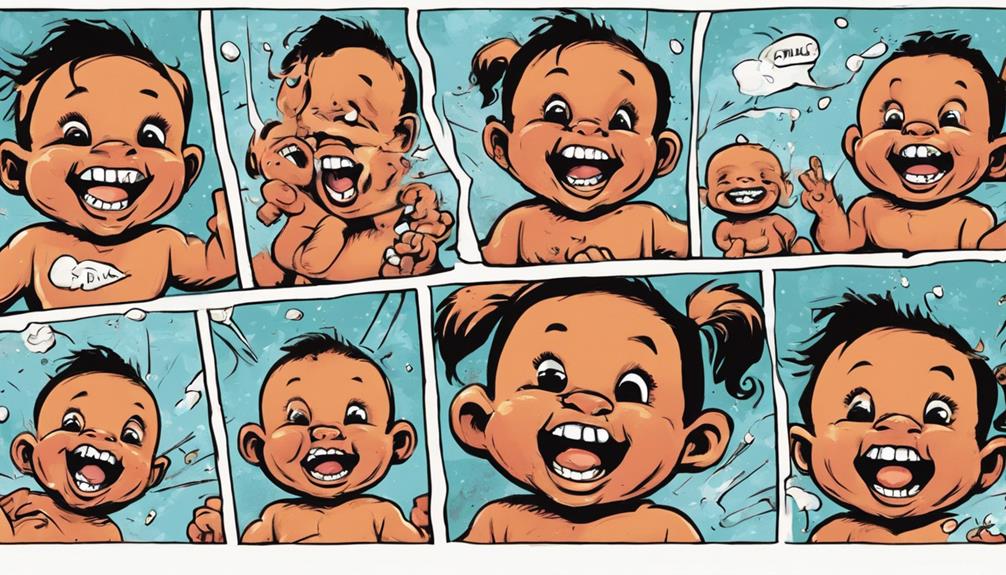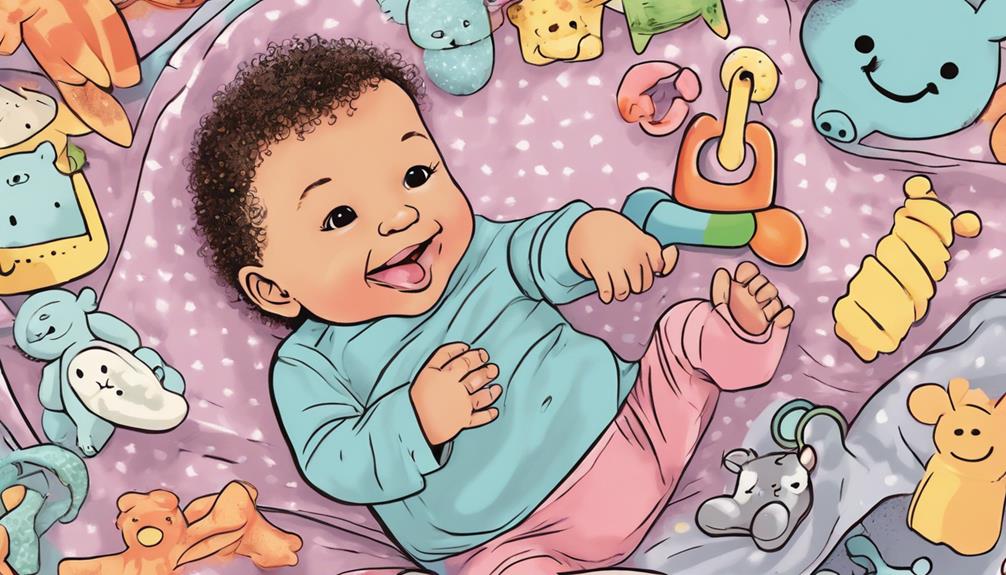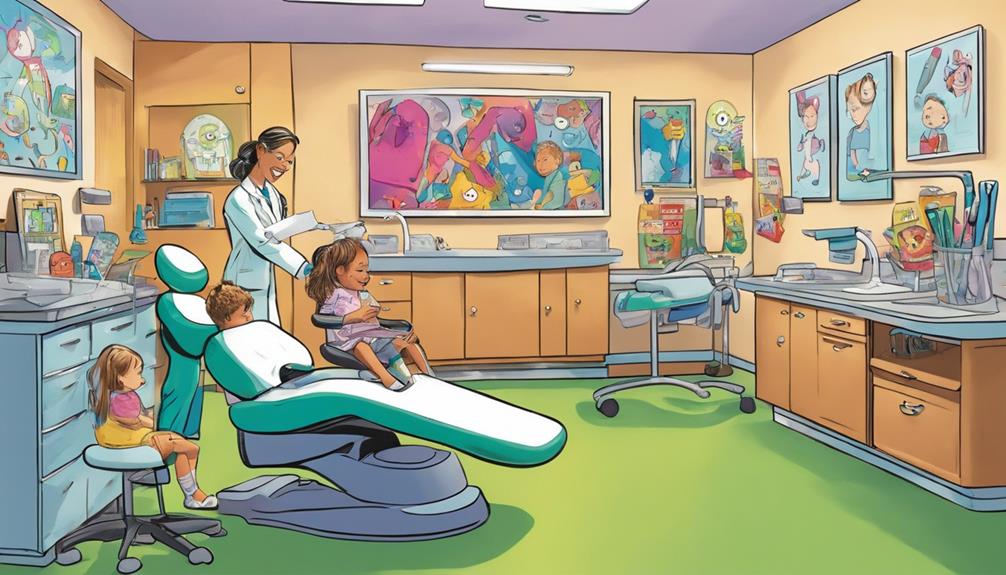Baby teeth typically start coming in around six months old, with the lower central incisors being the first to appear. You'll likely notice them erupting between six to ten months. Next, the upper central incisors follow, usually coming in between eight to twelve months. By age three, your child should have all 20 primary teeth. These first teeth help with chewing and speech development. As your little one grows, you might see some signs of teething discomfort. To keep your child's dental health in check, you'll want to know how to manage this process effectively.
Key Takeaways
- Teething typically begins around 6 months of age, with lower central incisors emerging first.
- Upper central incisors usually appear between 8-12 months, following the lower ones.
- By age 3, most children have all 20 primary teeth fully erupted.
- Approximately four baby teeth erupt every six months after the initial teeth.
Teething Timeline

Most babies start teething around 6 months old, though some might begin as early as 3 months or as late as 12 months. The teething timeline is generally predictable, with the lower central incisors being the first teeth to appear, typically between 6 and 10 months. After these lower teeth, the upper central incisors usually emerge around 8 to 12 months.
As your little one grows, you can expect that the teething process continues through the first three years of life. By the time they reach age 3, most children will have all 20 primary teeth, comprising central incisors, lateral incisors, canines, and molars. Following the eruption of the first teeth, about four baby teeth typically come in every six months.
During this period, your child may experience teething pain and discomfort, which can lead to various teething symptoms. Understanding the teething timeline helps you anticipate when those first teeth begin to appear and prepares you for the joyful yet challenging moments ahead.
As a parent, being informed can make this natural process a bit easier for both you and your baby.
Symptoms of Teething

Teething can bring a variety of symptoms, including swollen gums and increased drooling, that typically start around 6 months of age. As your baby's teeth begin to emerge, you might notice several signs indicating teething discomfort.
Here are three common teething symptoms to watch for:
- Swollen Gums: Your baby's gums may appear red and swollen as the teeth push through.
- Increased Drooling: You'll likely see more drooling than usual, which can lead to skin irritation around the mouth.
- Fussiness and Irritability: Your little one may become more irritable and fussy, struggling to find comfort.
Additionally, you might notice a slight elevation in temperature, generally not exceeding 100.4°F (38°C).
While some discomfort is normal, it's crucial to distinguish teething symptoms from those of an illness. If your baby develops a high fever, diarrhea, or a rash, it's time for a consultation with your healthcare provider.
Understanding these teething symptoms will help you provide the comfort and care your baby needs during this challenging time.
Eruption Order of Baby Teeth

As your baby navigates the teething process, understanding the order in which their baby teeth erupt can help you anticipate and manage their discomfort.
Typically, the first teeth to appear are the lower central incisors, coming in around 6-10 months. You'll likely notice the upper central incisors follow, usually emerging between 8-12 months.
Next up are the lateral incisors; the lower ones erupt between 10-16 months, while the upper lateral incisors come in between 9-13 months.
After that, expect the first molars to show up between 13-19 months, which can be a bit uncomfortable for your little one.
The canines, or cuspids, typically appear next, around 16-22 months.
Managing Teething Discomfort

Managing teething discomfort can be challenging, but there are effective strategies you can use.
You might find relief through safe soothing techniques and cold items, while knowing when to consult a pediatrician can guarantee your baby's comfort and health.
Let's explore these options to help your little one through this tough time.
Safe Soothing Techniques
Gently massaging your baby's gums with a clean finger can provide immediate relief from discomfort during this challenging time.
Teething can be tough for both you and your little one, but there are safe soothing techniques to help ease their teething discomfort. Here are a few methods to try:
- Teething Rings: Opt for soft, flexible teething rings that are safe for your baby. They can help soothe sore gums, but always watch your baby while they chew to prevent choking.
- Teething Biscuits: If you're using teething biscuits, monitor them closely. They can break into small pieces, posing a choking hazard.
- Gentle Gum Massage: Using your clean finger, gently massage your baby's gums. This can provide immediate relief and comfort.
Keep an eye out for any accompanying symptoms, like mild fever, which is normal (under 100.4°F).
However, if your baby has a high fever or concerning symptoms, consult a pediatrician. For additional relief, check with your healthcare provider before giving any pain relief medications.
Cold Relief Methods
Using cold items like chilled teething rings or frozen washcloths can effectively numb your baby's gums and reduce inflammation during teething. These methods can provide immediate relief for your little one, helping to soothe the discomfort associated with teething. However, it's crucial to choose safe options. Avoid liquid-filled teething rings, as they can break and pose a choking hazard. Instead, opt for solid rubber alternatives.
When using cold items, limit exposure to a short duration to prevent frostbite on sensitive gums. In addition to cold relief, massaging your baby's gums gently with a clean finger can also be beneficial. Always supervise infants while they use teething aids to guarantee their safety.
Here's a quick reference table for your convenience:
| Cold Relief Method | Benefits |
|---|---|
| Chilled Teething Rings | Numbs gums, reduces pain |
| Frozen Washcloths | Easy to manage, soothing |
| Gentle Gum Massaging | Provides comfort, promotes bonding |
Incorporating these cold relief methods can greatly alleviate your baby's teething discomfort while guaranteeing their safety.
When to Consult Pediatrician
Knowing when to consult your pediatrician about your baby's teething discomfort can help guarantee their well-being and address any underlying issues. While teething can cause discomfort, certain symptoms may indicate more serious medical conditions. Here are three situations where you should definitely reach out:
- High Fever: If your baby has a fever higher than 100.4°F (38°C) along with teething symptoms, consult your pediatrician. This could signal an illness rather than just teething pain.
- Persistent Irritability: If your baby is inconsolably crying or seems unusually irritable for an extended period, it's wise to consult your pediatrician to rule out other potential medical conditions.
- Gastrointestinal Symptoms: Should your baby experience diarrhea, vomiting, or a rash alongside typical teething symptoms, seek medical advice. These signs may not be linked to teething and could require attention.
Additionally, if you notice any bleeding or swelling that goes beyond normal teething discomfort, or if you have concerns about teething pain management, don't hesitate to consult your pediatrician for guidance. Your child's health is paramount.
Oral Hygiene for Infants

You should start cleaning your baby's gums with a soft cloth or gauze even before their teeth come in.
Once that first tooth appears, use a small, soft-bristled toothbrush with a smear of fluoride toothpaste to keep their mouth healthy.
Establishing these habits early can set the stage for a lifetime of good oral hygiene.
Importance of Early Cleaning
Establishing a daily oral hygiene routine for infants is critical for preventing decay and promoting healthy teeth as they begin to emerge. You should start cleaning your baby's gums even before the first tooth appears. This helps remove bacteria and prevents decay.
Here are three key steps to guarantee effective oral hygiene for your infant:
- Wipe Baby's Gums: Use a clean cloth or gauze to gently wipe your baby's gums daily. This helps maintain their oral hygiene and prepares them for brushing.
- Start Brushing: Once the first tooth erupts, switch to a soft-bristled toothbrush. Use a smear of fluoride toothpaste and brush twice a day to establish a healthy routine.
- Schedule a Dental Visit: Plan a dental visit by your child's first birthday or after the first tooth emerges. This visit helps monitor dental development and establishes a care routine.
As your baby's teeth come in, flossing should begin when two teeth touch, preventing cavities between teeth. By prioritizing oral hygiene from the start, you're setting the stage for a lifetime of healthy smiles.
Recommended Brushing Techniques
Brushing an infant's teeth requires gentle, effective techniques to confirm a positive experience as their dental care routine begins. Start by cleaning your baby's gums daily with a soft cloth or gauze, even before any teeth appear.
Once your baby's first tooth erupts, switch to a soft-bristled toothbrush. Use a small smear of fluoride toothpaste—just enough to cover the bristles—to brush their teeth and gums twice a day. This helps establish good oral hygiene habits early on.
For infants under 2 years, stick to that small smear, as a pea-sized amount is suitable for children over 3. It's crucial to supervise brushing until your child is about 7 or 8 years old; this confirms they're using proper brushing techniques and staying safe.
Don't forget to schedule your baby's first dental visit by their first birthday or when the first tooth appears. This visit helps set a solid dental care routine and allows you to monitor their oral health effectively.
Choosing Safe Teething Products

Choosing safe teething products is essential for your baby's comfort and well-being. When selecting teething toys, you want to prioritize safety to minimize any potential risks. Here are three key items to take into account:
- Solid Rubber Teethers: Opt for BPA-free solid rubber teethers. These are safe and durable, unlike those filled with liquid or breakable materials that can pose safety risks.
- Age-Appropriate Teething Toys: Always check for age-appropriate options and safety certifications. Verify the toys are designed specifically for your infant's developmental stage to avoid choking hazards.
- Avoid Teething Gels: Steer clear of teething gels that contain benzocaine, especially for infants under 2 years old. These can have serious side effects and aren't recommended.
Remember to supervise your baby while they're using any teething products. This not only verifies their safety but also allows you to intervene quickly if they encounter any issues.
Additionally, teething necklaces and bracelets should be strictly avoided due to the high risk of strangulation.
When to See a Dentist

You should see a dentist after your baby's first tooth erupts or by their first birthday to guarantee proper dental care. This early visit, often termed the first dental appointment, is essential for establishing a foundation for your baby's oral health. Pediatric dentists specialize in treating infants and young children, focusing on early detection of dental issues that may arise during teething and tooth eruption.
After the initial visit, it's recommended to schedule regular dental check-ups every six months. These visits help monitor your baby's dental development and hygiene, ensuring any concerns are addressed promptly. Establishing a dental home by age one promotes a consistent approach to your child's oral health and helps them build a positive relationship with dental care.
If you notice any unusual concerns, such as high fever, persistent irritability, or injuries to the mouth that go beyond typical teething symptoms, don't hesitate to consult your pediatrician or dentist. Early intervention can make a significant difference in your child's dental health, so take these steps seriously to support your baby's healthy smile.
Importance of Early Dental Care

Establishing early dental care sets the stage for a lifetime of healthy smiles and good oral hygiene habits. It's essential to start as soon as your child's first tooth erupts or by their first birthday.
Here are three key reasons to prioritize early dental care:
- Prevention of Tooth Decay: Applying fluoride varnish when teeth emerge strengthens enamel and helps prevent decay, ensuring your child's teeth stay healthy.
- Establish Routine: Cleaning your baby's gums with a soft cloth before teeth appear, and using a small, soft-bristled toothbrush with fluoride toothpaste after the first tooth comes in, helps foster healthy habits.
- Regular Dental Check-Ups: Schedule dental check-ups by age 1 to monitor tooth development and catch any issues early. This proactive approach can prevent complications down the road.
Additionally, educating yourself about the importance of avoiding sugary foods can greatly contribute to your child's oral hygiene.
Frequently Asked Questions
What Is the Average Age for a Baby First Teeth to Come In?
The average age for your baby's first teeth to come in is between 6 to 12 months. Most infants start teething around 6 months, with the lower central incisors typically emerging first. When baby teeth fall out, it typically occurs between the ages of 6 and 12 years old. The process of losing baby teeth and growing in permanent teeth is a natural part of a child’s development. It’s important to monitor the progress of your child’s teeth and consult with a dentist if you have any concerns.
What Is the Timeline of Baby Teeth Coming In?
You'll notice baby teeth typically emerge in a specific order over a few years. Central incisors usually come in first, followed by lateral incisors, molars, canines, and second molars, completing the set by age three.
Is It Normal for a 10 Month Old to Have No Teeth?
You might be worried, but it's completely normal for your 10-month-old to have no teeth yet. Every baby develops at their own pace, and some don't start teething until closer to their first birthday.
Is My 3 Month Old Teething?
At 3 months, your baby might show signs like increased saliva and mouthing, but it's often too early for true teething. Monitor their behavior and consult a pediatrician if discomfort persists.
Is There a Specific Timeline for Baby Teeth to Come in?
The baby teeth eruption timeline varies for every child, but generally, the first tooth appears around six months, with the full set by age three. However, some kids may experience delayed tooth eruption, while others may have all teeth before their first birthday.
Conclusion
In conclusion, understanding your baby's teething timeline can help you navigate this challenging phase.
Did you know that most babies have their first tooth by around six months, but some mightn't get one until their first birthday?
It's essential to manage their discomfort and maintain good oral hygiene early on.
Remember, regular check-ups can set the foundation for a healthy smile.
So, keep an eye on those tiny gums, and don't hesitate to consult a dentist if needed!









